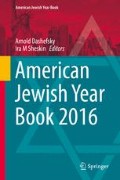Abstract
The Canadian Jewish population has seen only modest growth in the past 20 years, following a more significant increase between 1981 and 1991. The latter decade coincided with the beginning of significant immigration by Jews from the Former Soviet Union. Jews reside in every region of Canada including the Northern Territories, although they are concentrated heavily in the major urban centers. The metropolitan area of Toronto is home to 188,710 Jews, and includes about half (48.2 %) of Canada's Jewish population. The Montreal community numbers 90,780 Jews. The median age of Canadian Jews is slightly older than the national average, but much older than ethnic groups with large numbers of more recent immigrants. The Canadian Jewish population has a slightly larger proportion of children (age 0–14) than the total population (18.2 % and 17.0 % respectively) and a significantly larger proportion of persons over age 65 than the overall Canadian population (16.9 % and 13.9 % respectively). There are 17,300 Holocaust Survivors living in Canada, composing 0.4 % of the country’s total senior population of 4,221,245. Survivors represent 28.2 % of Canada’s Jewish seniors. In short, more than a quarter (28.2 %) of 61,270 elderly Jews over age 65 are Survivors.
Access this chapter
Tax calculation will be finalised at checkout
Purchases are for personal use only
Notes
- 1.
A census is also distributed in the middle of every decade (most recently in May of 2016), but it does not contain a religion question and, therefore, is much less useful for identifying Jews.
- 2.
In the case of Jewish communities, it is possible that the ultra-Orthodox were also under-represented in the final count.
- 3.
For a more comprehensive description of the erosion of the utility of the ethnicity variable in identifying Jews, see Weinfeld and Schnoor (2015).
- 4.
More specifically, the US Census asks only one ethnicity-related question identifying respondents of Hispanic or Latino descent. The American Community Survey, an annual demographic study of the US population, does ask questions on “ancestry” and language spoken at home.
- 5.
The NHS does not ask specific questions such as denominational affiliation, levels of religious observance, attitudes toward Israel, etc. For these data, the Jewish community needs to develop its own survey tools.
- 6.
All 2011 NHS data cited in this chapter were derived from Statistics Canada, special order tabulations for Jewish Federations of Canada – UIA, CO-1421. Most of the descriptions related to the data were adapted from Shahar (2014).
- 7.
The descriptions related to Holocaust Survivors were adapted from Shahar (2015). An attempt was made to conform as much as possible to the criteria specified by the Claims Conference’s Jewish Nazi Victim Definition (2013).
References
Shahar, C. 2014. 2011 National Household Survey analysis: The Jewish population of Canada. Part 1: Basic demographics and Part 2: Jewish populations in geographic areas. Toronto: Jewish Federations of Canada – UIA. See: www.jewishdatabank.org.
Shahar, C. 2015. 2011 National Household Survey analysis: The Jewish population of Canada. Part 9: Holocaust Survivors. Toronto: Federations of Canada – UIA. See: www.jewishdatabank.org.
Shahar, C. 2016. Jewish population of Canada, 2015. In American Jewish year book 2015, vol. 115, ed. A. Dashefsky and I.M. Sheskin, 261–272. Dordrecht: Springer.
Shahar, C., and T. Rosenbaum. 2006. Jewish life in Greater Toronto: A survey of the attitudes & behaviors of Greater Toronto’s Jewish community. Toronto: UJA Federation of Greater Toronto.
Weinfeld, M., and R.F. Schnoor. 2015. The demography of Canadian Jewry, the “census” of 2011: Challenges and results. In American Jewish year book 2014, vol. 114, ed. A. Dashefsky and I.M. Sheskin, 285–300. Dordrecht: Springer.
Author information
Authors and Affiliations
Corresponding author
Editor information
Editors and Affiliations
Rights and permissions
Copyright information
© 2017 Springer International Publishing AG
About this chapter
Cite this chapter
Shahar, C. (2017). Canadian Jewish Population, 2016. In: Dashefsky, A., Sheskin, I. (eds) American Jewish Year Book 2016. American Jewish Year Book, vol 116. Springer, Cham. https://doi.org/10.1007/978-3-319-46122-9_16
Download citation
DOI: https://doi.org/10.1007/978-3-319-46122-9_16
Published:
Publisher Name: Springer, Cham
Print ISBN: 978-3-319-46121-2
Online ISBN: 978-3-319-46122-9
eBook Packages: Social SciencesSocial Sciences (R0)

